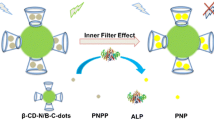Summary
To provide for bioluminescence measurements of the enzymatic activities of dehydrogenases, disturbing contaminants were removed from a bacterial luciferase extract by chromatography, using Blue Sepharose CL-6B, a cross-linked agarose to which Cibacrone Blue F3G-A is covalently attached. This compound has a strong affinity to the dinucleotide fold, which is a region in enzymes binding NAD(H) or NADP(H). In contrast to the absorbed dehydrogenases, both luciferase and oxidoreductase were easily eluted and appeared close to the main bulk of UV-absorbing but analytically less important material. A rapid recording of the elution of luciferase was accomplished with a new electrochemical bioluminescence assay. Due to this and the early elution of the desired material, it could be chromatographed, recognized and collected in less than two hours. Thereby the light-yielding capacity of the sensitive material was well preserved.
For bioluminescence assay solutions composed of pooled oxidoreductase-luciferase fractions, FMN and a long chain aldehyde were prepared and supplemented with NAD+ and either lactate, malate or 3-hydroxybutyrate. The analyses were carried out in a single step performance by adding the enzyme sample to the luciferase solution. Minute amounts of lactate dehydrogenase, malate dehydrogenase and 3-hydroxubutyrate dehydrogenase yielded a linear light response permitting assay in the lower part of the fentomole region. In case a dehydrogenase does not occur as a contaminant of a commercial luciferase preparation, purification with Cibacrone Blue can be omitted as demonstrated for glucose-6-phosphate dehydrogenase. The single step performance is suitable for microassay of enzymes as in fine needle or punch biopsies, in search of contaminants for control of purification, for studies of small cell populations separated by cell sorters and whenever else a low level of detectability is essential to attain.
Similar content being viewed by others
References
Glick, D., 1977. J. Histochem. Cytochem. 25: 1087–1101.
Hastings, J. W., Riley, W. H. and Massa, J., 1965. J. Biol. Chem. 240: 1473–1481.
Lee, J., 1972. Biochem. 11: 3350–3359.
Gunsalus-Miguel, A., Meighen, E. A., Nicoli, M. Z., Nealson, K. H. and Hastings, J. W., 1972. J. Biol. Chem. 247: 398–404.
Puger, K. and Michelson, A. M., 1972. Biochimie 54: 1197–1204.
Brolin, S. E. and Hjertén, S., 1977. Mol. Cell. Biochem. 17: 61–73.
Stanley, P. E., 1971. Anal. Biochem. 39: 441–453.
Brolin, S. E., Berglund, E., Tegnér, L. and Wettermark, G., 1971. Anal. Biochem. 42: 124–135.
Brolin, S. E. and Wersäll, P., 1980. Mol. Cell. Biochem. 32: 5–12.
Ågren, A., Brolin, S. E. and Hjertén, S., 1977. Biochim. Biophys. Acta 500: 103–108.
Brolin, S. E. Ågren, A., Wersäll, J. P. and Hjertén, S., 1979. In: Analytical Applications of Bioluminescence and Chemiluminescence (Schram, E. and Stanley, P. E., eds.), pp. 109–121, State Printing & Publ. Inc., Westlake Village, California, U.S.A.
Hutton, J. C., Sener, A. and Malaisse, W. J., 1979. In: Analytical Applications of Bioluminescence and Chemiluminescence (Schram, E. and Stanley, P. E., eds.), pp. 257–262, State Printing & Publ. Inc., Westlake Village, California, U.S.A.
Brolin, S. E., 1977. Bioelectrochem. Bioenerg. 4: 257–262.
Stanley, P. E., 1978. In: Methods in Enzymology (De Luca, M., ed.), Vol. 57, pp. 181–188, Academic Press, New York, U.S.A.
Thore, A., 1979. Ann. Clin. Biochem. 16: 359–369.
Thompson, S. T., Cass, K. H. and Stellwagen, E., 1978. Proc. Natl. Acad. Sci. USA 72: 669–672.
Easterday, R. L. and Easterday, I., 1974. In: Immobilized Biochemicals and Affinity Chromatography (Dunlop, R. B., ed.), pp. 123–133, Plenum Press, New York.
Wettermark, G. and Brolin, S. E., 1979. In: Analytical Applications of Bioluminescence and Chemiluminescence (Schram, E. and Stanley, P. H., eds.), pp. 212–220, State Printing & Publ. Inc., Westlake Village, California, U.S.A.
Small, E. D., Koka, P. and Lee, J. J., 1980. J. Biol. Chem. 255: 8804–8810.
Jablonski, E. and De Luca, M., 1979. In: Analytical Applications of Bioluminescence and Chemiluminescence (Schram, E. and Stanley, P. H., eds), pp. 122–134, State Printing & Publ. Inc., Westlake Village, California, U.S.A.
Author information
Authors and Affiliations
Rights and permissions
About this article
Cite this article
Brolin, S.E. Single-step bioluminescence analyses of enzymes, using Cibacrone Blue chromatography for removal of interfering dehydrogenases. Mol Cell Biochem 55, 177–182 (1983). https://doi.org/10.1007/BF00673711
Received:
Issue Date:
DOI: https://doi.org/10.1007/BF00673711




